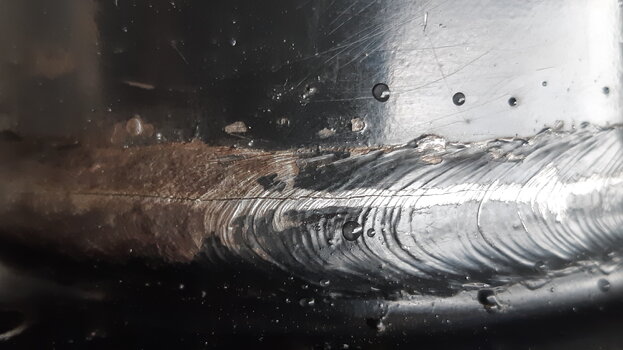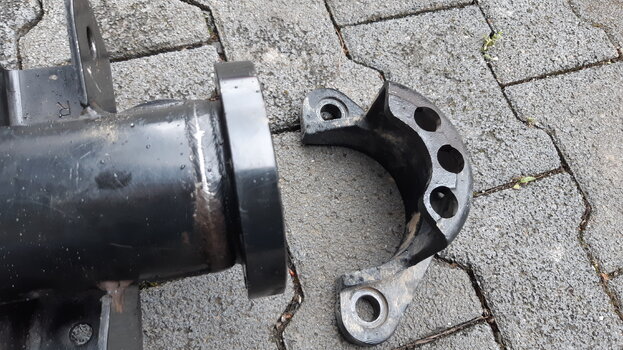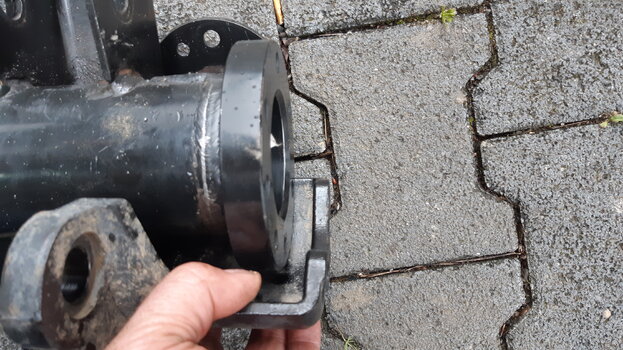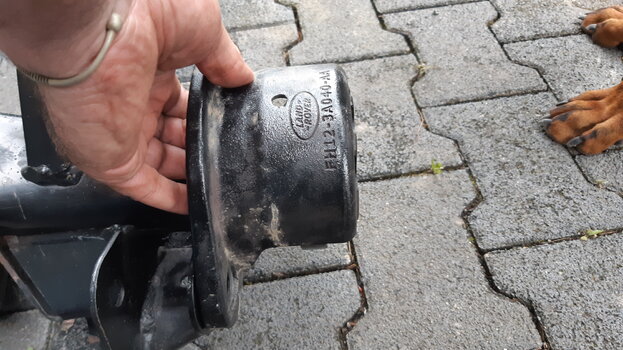These pictures are from a FB feed from 4WD TV in Australia. https://www.4wdtv.com.au/ This crew does some difficult four-wheel driving in a live axle Iveco Daily 4x4 truck and produce videos and travel shows for commercial tv stations. Iveco Daily has the larger version of the Carraro axle with mechanical diff locks and are very close in design to the axles used in Grenadier and Quartermaster. The photos are for general interest and research, to illustrate the construction of the axle and that even the strongest looking components have an eventual failure point.


The Grenadier Forum
Register a free account today to become a member! Once signed in, you'll be able to contribute to the community by adding your own topics, posts, and connect with other members through your own private inbox! INEOS Agents, Dealers or Commercial vendors please contact admin@theineosforum.com for a commercial account.
You are using an out of date browser. It may not display this or other websites correctly.
You should upgrade or use an alternative browser.
You should upgrade or use an alternative browser.
Not an Ineos axle breakage. What would you do in a similar situation?
It's not caused by fatique but clearly by excessive force or material failure on inner universal joint. Track rod and drag link look intact. If caused by force possible reasons include:
- Front diff lock engaged, steering at full stop and good traction on both front tyres causing huge internal force on front axle.
- Front diff lock engaged, steering at full stop and opposite tyre in air causing maximum driving force to this side.
- Steering angle stop bolt failure or adjustment over threshold.
- Remove broken drive shaft parts (half shaft parts) from inside the swivel housing.
- Block differential oil escaping to swivel housing.
- Put knuckle back.
- Force front diff lock on by a jump wire (if electrically operated).
- Get back home on 3 x 4.
Thats a good explanation, I'll change the thread to "What would you do in a similar situation?"It's not caused by fatique but clearly by excessive force or material failure on inner universal joint. Track rod and drag link look intact. If caused by force possible reasons include:
If this would happen to me in the outback and no spares would be available my survival plan would be:
- Front diff lock engaged, steering at full stop and good traction on both front tyres causing huge internal force on front axle.
- Front diff lock engaged, steering at full stop and opposite tyre in air causing maximum driving force to this side.
- Steering angle stop bolt failure or adjustment over threshold.
- Remove broken drive shaft parts (half shaft parts) from inside the swivel housing.
- Block differential oil escaping to swivel housing.
- Put knuckle back.
- Force front diff lock on by a jump wire (if electrically operated).
- Get back home on 3 x 4.
Most failures I have seen occur when the front lock is engaged the steering is turned a bit or with larger tyres, people driving hard to get through an obstacle that lifts and unloads a wheel then lands hard with very high sudden traction then axle failure. A few of the axles I have changed have had previous noticeable torque related cracking prior to the final failure.
My solution would be very similar. I would also remove the last good section from the double cardan and fit it back into the wheel spindle to hold the spindle and the wheel bearing together and allow normal driving without the risk of the wheel bearing and hub separating. Not sure if this is required with Carraro axle but on some IFS front ends this needs to be done for safety. If it was an outback road, in Australia most outback roads only need ground clearance, I would take the front drive shaft out and lock the t/case centre diff and drive in 4x2 if it was rougher terrain or wet I would use the same method as you described.
I saw a broken axle on a Defender years ago. It was a Td4 2.4l...Land Rover switched from friction welding to normal welding of the swivel house casing to the axle tube. That didn't work, hair cracks developed, oil was leaking and then it failed. That caused a huge call back in two waves. But instead fitting a new axle you got a sleeve which does not prevent the failure, but that you loose you wheel at full speed. Absolutely irresponsible from my point of view. Even if you do not loose your wheel, other things may happen when it fails. Our 110 was called back in the second call back, even it has a friction welded axle....we didn't understand that, but we had to follow the call back as we would have lost the permission to drive the car, otherwise.
I must search the photo....
Edited: here we are, I have no access to the photo of the broken Defender, now,but later...
You see the crack and the clamp fitted to the axle to keep thing in place.




AWo
I must search the photo....
Edited: here we are, I have no access to the photo of the broken Defender, now,but later...
You see the crack and the clamp fitted to the axle to keep thing in place.




AWo
Last edited:
Not just a LR thing, cracking axle housings is a common occurrence on most live axle 4x4s and trucks on out back roads when people continuously hit a wash outs, dips and creek beds fast in a heavily loaded vehicle. There is a lot of flex in an axle housing. I would not expect it on normal road use or moderate off-road use.I saw a broken axle on a Defender years ago. It was a Td4 2.4l...Land Rover switched from friction welding to normal welding of the swivel house casing to the axle tube. That didn't work, hair cracks developed, oil was leaking and then it failed. That caused a huge call back in two waves. But instead fitting a new axle you got a sleeve which does not prevent the failure, but that you loose you wheel at full speed. Absolutely irresponsible from my point of view. Even if you do not loose your wheel, other things may happen when it fails. Our 110 was called back in the second call back, even it has a friction welded axle....we didn't understand that, but we had to follow the call back as we would have lost the permission to drive the car, otherwise.
I must search the photo....
Edited: here we are, I have no access to the photo of the broken Defender, now,but later...
You see the crack and the clamp fitted to the axle to keep thing in place.
View attachment 7873684
View attachment 7873685
View attachment 7873686
View attachment 7873687
AWo
I have watched a few of these videos he has good information relevant for all vehicle makes not just LR.
I can see companies like Multidrive Technologies, Superior Engineering and Jmacx offering axle trussing and chassis extensions and other modifications to increase the Quartermasters GVM for people using the overused cliche and building the "Game changing touring rig"
I beleive the hub is fully floating with separate bearings, but not 100% sure. In this case the bearings are held with a nut on the stub axle. Like older LR axles.I would also remove the last good section from the double cardan and fit it back into the wheel spindle to hold the spindle and the wheel bearing together and allow normal driving without the risk of the wheel bearing and hub separating.
In case of a hub assembly (with integrated bearings) the shaft is needed.
These photos came from the "Ineos Grenadier Owners-USA" FB page. I was hoping that the photos would have made it to this forum so hopefully if the owners of the photos are on this forum they can explain further about disassembly and assembly. With the difficulty in getting manuals these photos are going to help mechanics that are in regional workshops that may have to replace wheel bearings or wheel studs. Thanks to the original posters for the photos.
Some photos of the Ineos front Carraro axle disassembled showing the axle, double cardan joints, swivel housing etc.


Like the Iveco front axle a workshop may have to build a wheel bearing pressing jig to make the job easier and safer as the bearings do need a good amount of force to remove from the housing and replace. From all accounts with the Iveco axles it's a good idea to replace the wheel bearing if they have been pressed out even if they feel good as there has been reported premature failures of reused bearings. This may be a good idea in the Ineos as well. Just need wheel bearing numbers to track down aftermarket ones because they are generally the same brand as the OEM without the OEM spare parts markups.

Double cardan joint front axle

Some photos of the Ineos front Carraro axle disassembled showing the axle, double cardan joints, swivel housing etc.
Like the Iveco front axle a workshop may have to build a wheel bearing pressing jig to make the job easier and safer as the bearings do need a good amount of force to remove from the housing and replace. From all accounts with the Iveco axles it's a good idea to replace the wheel bearing if they have been pressed out even if they feel good as there has been reported premature failures of reused bearings. This may be a good idea in the Ineos as well. Just need wheel bearing numbers to track down aftermarket ones because they are generally the same brand as the OEM without the OEM spare parts markups.
Double cardan joint front axle
No, I don't think it is broken. I sure OP on FB disassembled it for general interest and aftermarket product development. The DC axle looks like it may have been hot at some stage, but it is likely the heat treatment to make that position a bearing surface. From the image it looks like a plain bearing that runs directly on the axle but that is difficult to tell. This makes me think it may be beneficial to run the front axle oil level to the level plug to ensure the outer bearing is always properly lubricated. The 2.1 litres and level below the fill plug seems to be a minimum fill capacity for some sort of environmental reason.Is that the broken thing? I see heavy signs of wear on the shaft in the middle picture. And it seems to got hot (colour). What is located there? A bearing or a seal?
AWo
Last edited:
Not sure if this is normal for these axles. There is no way of telling how deep those grooves are in the axle without a physical inspection. It does look like wear on the bearing surface, but the discolouration looks to be from the heat treatment of the axle and the bearing looks to be the original colour and has not totally failed. Some clarification from the OP would be good.
Similar threads
- Replies
- 36
- Views
- 4K



